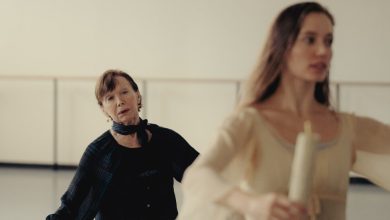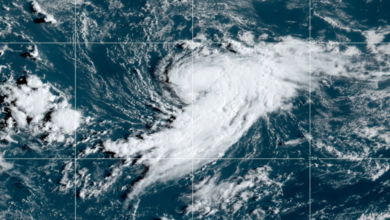Pride March in New York Infused With New Sense of Urgency

The festivities began on Sunday with a familiar feel: Revelers adorned in a palette of bright colors, waving rainbow flags and handmade signs, tossing confetti into the air as the roar of screams and bikers revving their motorcycle engines signaled the start of the annual New York City Pride March in Manhattan.
But there was no mistaking that this year’s event, for all its joyous celebrations, had taken on sudden urgency and heightened significance just two days after the United States Supreme Court overturned the constitutional right to abortion and signaled that the court could reconsider other liberties, including the 2015 decision that allowed same-sex marriage.
Those thoughts were on the minds of three high school friends from New York City who arrived two hours before the parade began on Sunday to grab an upfront view at the starting point near the Flatiron Building in Manhattan.

The Pride march began in the Flatiron district of Manhattan with a joyous celebration.Credit…Stephanie Keith for The New York Times
“Because of all the recent stuff that’s been happening, I’m glad that we have the chance to be with people we know who support us,” said Ivey Espinosa, 17, who identifies as nonbinary and attends Fort Hamilton High School in Bay Ridge, Brooklyn. “There’s more importance, more urgency.”
Moments later, Planned Parenthood — which event organizers decided to place at the head of the event after the decision to overturn Roe v. Wade — led the way as the first groups of the Pride March rolled down Fifth Avenue. A joyous and diverse scene of people of all ages from across the country had packed sidewalks, congregated on building fire escapes and climbed scaffolding to watch the parade.
Amid chants of “Rise up for abortion rights,” Christian Rodriguez trailed the Planned Parenthood marchers with a homemade sign held above his head. It mentioned the Supreme Court decisions about contraception, consensual same-sex relations and same-sex marriage — all of which Justice Clarence Thomas, a member of the majority, suggested in a concurring opinion should be reconsidered by the court.
“In Clarence Thomas’s concurring opinion, he just couldn’t wait to say the quiet part out loud,” said Mr. Rodriguez, 22, who lives in New York City. “There is a very strong case to be made that women’s liberation is inextricably tied to gay liberation.”
About an hour before the start of the Pride March, several elected officials strolled down Fifth Avenue past significantly smaller crowds than those that gathered for the main event. They included Mayor Eric Adams, who was surrounded by dozens of police officers, and Senator Chuck Schumer, the Democrat of New York and the majority leader.
Using a bullhorn, Mr. Schumer stopped at West 17th Street and Fifth Avenue and announced that he was proud to march with his daughter, Alison Schumer, and her wife, Elizabeth Weiland.
As Mr. Schumer continued walking, a man yelled out that he needed to do more to protect people’s civil rights. “We are fighting the fight, and we are going to win,” Mr. Schumer responded.
More than a half-century after the landmark uprising at the Stonewall Inn in 1969 helped galvanize the fight for gay rights, the annual New York City Pride March has become an event of unapologetic jubilation.
But both revelers on the sidelines and those in the march said on Sunday that current state of affairs in United States required renewed activism to maintain and expand civil rights for women and for people who identify as lesbian, gay, bisexual and transgender.
“Pride has always gone back and forth between these two things: It’s a riot or a celebration,” said Cynthia Nixon, the actress and former candidate for governor, who marched behind the Planned Parenthood group. “In more recent years, it’s been a celebration, but today, it’s a protest.”
Her sober sentiment was repeated by the numerous people who lined Fifth Avenue. Many had traveled to New York City from out of the state, including Kelsey Sutton, 15, who lives in a rural county in Iowa and recently came out as agender. Her aunt, Lynsie Slachetka, said Kelsey would not have found the same receptive community in her home state.
Despite the recent news, Kelsey said they were hopeful for the future and thankful to grow up in an era of expanded gay rights. “I feel like things are getting better,” Kelsey said.
While the New York City Pride March was the largest of its kind over the weekend in Manhattan, revelers also celebrated the end of Pride Month at events across the city. They included the Queer Liberation March, which began in response to criticism that the larger Pride March had become too corporate.
Charlotte Dragga, 36, a trans woman from Durham, N.C., who on Sunday came to Foley Square in Lower Manhattan for the Queer Liberation March, called the Supreme Court decision to overturn Roe v. Wade “absolutely atrocious.”
“It’s just the beginning. What will be next? Gay marriage? Trans rights?” said Ms. Dragga. “It’s just going to get worse. It’s going to have impacts beyond just abortion.”
Kymme Napoli, 42, of Park Slope, Brooklyn, a counselor in a public hospital who often helps people struggling with the decision of whether to get an abortion, said the overturning of Roe v. Wade “made people want to come out more, to show more support for each other.”
Crying as she spoke, she said, “I fear for people who aren’t in states like New York.”
On Saturday, Athina Schmidt, 33, traveled from South Carolina to New York City to celebrate Pride at the 30th annual Dyke March at Bryant Park in Manhattan. Ms. Schmidt said that the weekend of events was about inclusivity and acceptance.
“It’s about seeing all these women and feeling like we fit in somewhere,” said Ms. Schmidt, who identifies as bisexual or pansexual.
Ms. Schmidt is scared of what overturning Roe means for women and the queer community. “I’m very scared, they’re coming for everything next, we’re going to be illegal again,” she said. “They’re going to take our IUDs? What’s next?”
Maggie Goldstone, who attended the GayJoy and Lex party in East Williamsburg, Brooklyn, with her partner on Saturday, said she felt conflicted about being joyful and celebrating Pride.
“There’s an inherent connection between queer liberation and the ruling,” she said, “and because of that it’s really important for people to enjoy what they’re going to do this weekend and not be drowned out by fear.”
She said the diversity of New York City Pride is empowering because of the visibility it offers. “There’s a sense of anything possible in New York, there’s so many identities here,” she said. But she said she worried that the court decision would affect how women everywhere view themselves: “You can’t reach your full potential if you perceive yourself as second-class citizen.”





